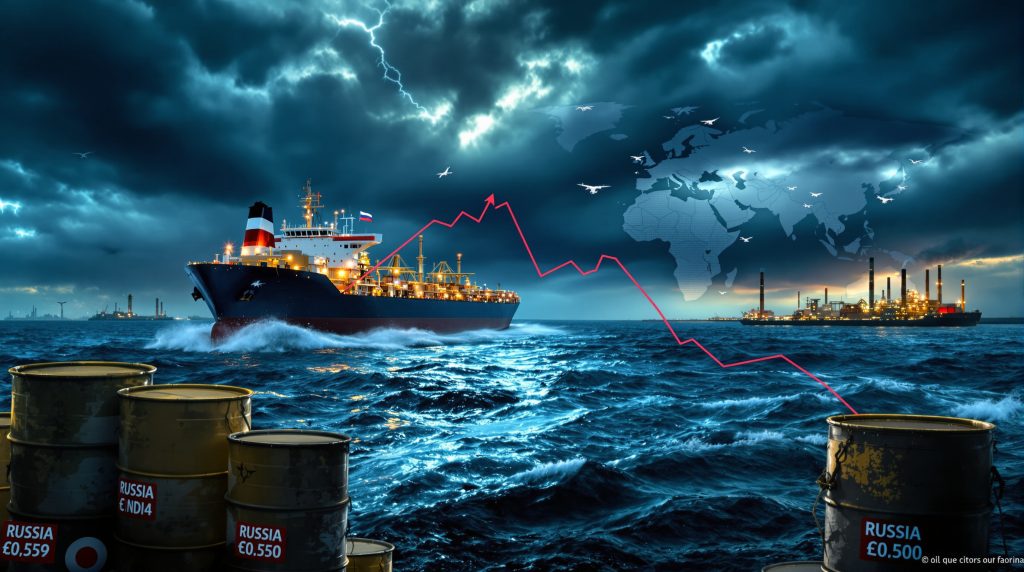Why Are Russia's Oil Export Revenues Declining?
Russia's oil and fuel export revenues have entered a sustained downward spiral in 2025, marking a significant shift in the country's economic outlook. This decline represents more than just a temporary fluctuation—it signals structural challenges facing one of the world's largest energy exporters amid changing market dynamics and ongoing geopolitical tensions.
The revenue decline stems from a perfect storm of factors: falling global oil prices, reduced export volumes (particularly for refined products), and the persistent impact of Western sanctions. As these pressures intensify, Russia's position in global energy markets continues to weaken despite attempts to pivot to alternative buyers.
How Significant Is the Revenue Decline?
The Scale of Revenue Losses
The decline in Russia's oil and fuel export earnings has been substantial throughout 2025. Revenue from petroleum exports has fallen by approximately 20% year-on-year for the first nine months of 2025 compared to the same period in 2024. This represents billions in lost income for the Russian federal budget, which has historically relied on energy exports for approximately 40-45% of its revenue.
Monthly Trend Analysis
Monthly data reveals an accelerating decline pattern:
| Month (2025) | Revenue Change (YoY) | Key Factors |
|---|---|---|
| July | -15% | Price pressure, stable volumes |
| August | -18% | Refinery disruptions begin |
| September | -23% | Refined product exports hit decade low |
September 2025 marked a particularly troubling milestone for Russian energy exports, with refined product shipments falling to their lowest level in a decade (excluding the pandemic-driven anomaly of April 2020). Even with a modest increase in crude oil export volumes in September (reaching 5.1 million barrels per day), overall oil revenues still declined to a three-month low, highlighting how price pressures have overwhelmed volume gains.
What's Driving the Price Compression?
Global Oil Price Environment
The global oil market has shifted dramatically from the tight supply conditions of 2022-2023 to an emerging oversupply situation in 2025. Benchmark crude prices have fallen steadily, with WTI crude trading below $60 per barrel and Brent hovering around $62 per barrel in October 2025.
For Russia specifically, the price decline has been even more pronounced. The country's primary export grade, Urals crude, has been trading at significant discounts:
- Currently trading below $56 per barrel in many markets
- Consistently below the Western price cap of $60 per barrel
- At discounts of $8-12 per barrel to Brent crude (compared to historical discounts of $1-3)
OPEC+ Production Increases
A key factor driving the global price decline has been increased production from OPEC+ members:
- Saudi Arabia has gradually unwound voluntary production cuts
- Several OPEC+ members exceeded their quotas in Q3 2025
- The group added approximately 630,000 barrels per day of production in September alone
This production surge has coincided with slowing demand growth in key markets like China, creating downward pressure on global oil prices that particularly affects higher-cost or sanctioned producers like Russia. The recent OPEC meeting impact has further complicated Russia's position in global energy markets.
How Have Sanctions Impacted Russian Oil Exports?
Price Cap Mechanism Effectiveness
The G7 oil price cap, initially viewed skeptically by many analysts, has proven more effective than expected in 2025. The $60 per barrel cap on Russian seaborne oil exports has:
- Forced Russia to sell at discounted rates to maintain market access
- Limited Russia's ability to capitalize on any price spikes
- Reduced the country's bargaining power with buyers
Recent analysis shows that approximately 75% of Russian seaborne oil is now trading at or below the price cap, compared to about 60% in early 2024, indicating strengthened enforcement.
Shipping and Insurance Restrictions
Western shipping and insurance restrictions have also tightened throughout 2025:
- The share of Russian oil transported by G7 and allied tankers has increased to over 50% of seaborne shipments
- Russia's "shadow fleet" of tankers has diminished in effectiveness due to:
- Increased scrutiny and enforcement
- Technical challenges and maintenance issues
- Higher operational costs
These shipping constraints have further limited Russia's ability to circumvent sanctions and maintain premium pricing in alternative markets.
What's Happening to Russian Refined Product Exports?
Refinery Disruptions
A series of Ukrainian drone strikes on Russian refineries throughout 2025 has caused significant disruptions to the country's refining capacity:
- An estimated 15-20% of Russia's refining capacity has been damaged
- Several major facilities remain offline or operating at reduced rates
- Repairs are progressing slowly due to limited access to Western technology and parts
Industry analysts project that Russian refining capacity may not fully recover before mid-2026, creating a prolonged constraint on the country's ability to export higher-value refined products.
Product Export Trends
The impact on refined product exports has been dramatic:
- Diesel exports have fallen by approximately 30% year-on-year
- Gasoline exports have declined by over 40%
- Jet fuel exports have decreased by about 25%
These declines represent not just volume losses but also significant revenue impacts, as refined products typically command higher prices and margins than crude oil. Moreover, the oil price trade war has further complicated Russia's ability to secure favorable terms for its exports.
Where Is Russian Oil Being Diverted?
Market Redirection Efforts
Russia has attempted to redirect its oil exports to alternative markets, with mixed results:
- India has emerged as the largest buyer of Russian crude, with imports averaging 1.9 million barrels per day in 2025
- China remains a significant customer but has leveraged Russia's limited options to negotiate deeper discounts
- Several smaller Asian markets have increased purchases but at heavily discounted rates
Challenges in New Markets
Despite these redirections, several challenges have limited Russia's success in new markets:
- Payment and logistics complications due to banking sanctions
- Higher transportation costs to more distant markets
- Limited refining compatibility with some Russian crude grades
- Buyer leverage to demand steeper discounts
These factors have meant that while Russia has maintained export volumes to some degree, revenue generation has suffered disproportionately. Additionally, trade war pressures have complicated global market dynamics for all energy exporters.
What Are the Economic Implications for Russia?
Budget Impact
The decline in oil and gas revenues has created significant pressure on Russia's federal budget:
- Energy revenue shortfalls of approximately 20% year-on-year
- Widening budget deficit, projected to reach 3.5-4% of GDP in 2025
- Increased reliance on the National Wealth Fund to cover shortfalls
Economic Growth Concerns
The Russian economy ministry has recently warned that the country is approaching recession territory, with:
- Q3 2025 showing near-zero growth
- Manufacturing sectors dependent on energy inputs struggling
- Rising inflation partially attributed to higher domestic energy costs
Currency Pressure
The Russian ruble has also faced increased pressure, partly due to declining energy export revenues:
- Trading at multi-year lows against major currencies
- Requiring significant central bank intervention
- Contributing to imported inflation
The tariffs affecting markets have further complicated Russia's economic outlook as global trade tensions persist.
What's the Outlook for Russian Oil Revenues?
Near-Term Projections
Analysts project continued pressure on Russian oil revenues through the remainder of 2025 and into 2026:
- Global oil prices expected to remain under pressure due to supply growth outpacing demand
- Refinery capacity constraints likely to persist for at least 6-9 more months
- Potential for further sanctions tightening, with discussions about lowering the price cap to $45 or even $30 per barrel
Potential Mitigating Factors
Several factors could potentially provide some relief to Russian oil revenues:
- Any significant geopolitical disruptions that tighten global oil markets
- OPEC+ production cuts in response to falling prices
- Technical breakthroughs in repairing damaged refining capacity
However, most industry observers consider these mitigating factors unlikely to fully offset the structural challenges facing Russian oil exports.
How Might Western Sanctions Evolve?
Sanctions Effectiveness Debate
The evident impact of current sanctions has sparked debate about potential adjustments:
- Proponents argue for tightening the price cap to further restrict Russian revenues
- Some analysts suggest targeting Russia's shadow fleet more aggressively
- Others recommend focusing on closing loopholes in existing mechanisms rather than introducing new measures
Potential New Measures
Several potential sanctions adjustments are under consideration:
- Lowering the price cap from $60 to a range of $30-45 per barrel
- Expanding secondary sanctions on financial institutions facilitating Russian oil trades
- Increasing enforcement resources for monitoring compliance
- Targeting key logistics and transportation nodes in Russia's export infrastructure
The effectiveness of these potential measures would depend significantly on implementation details and international coordination. A comprehensive recession impact analysis suggests that energy markets may face additional volatility if global economic conditions deteriorate further.
What Does This Mean for Global Oil Markets?
Supply-Demand Balance
The decline in Russian refined product exports has created regional imbalances in global markets:
- European diesel markets have tightened, with increased imports from Middle Eastern and Asian refiners
- Asian markets have seen increased competition as Russian crude flows east
- U.S. refiners have found new export opportunities to fill gaps left by reduced Russian products
Price Implications
Despite these regional shifts, the overall global market remains well-supplied:
- Benchmark crude prices have trended downward throughout much of 2025
- Refined product cracks (the price difference between crude oil and refined products) have widened in some regions
- Market volatility has increased, particularly around geopolitical developments
Long-Term Market Restructuring
The sustained decline in Russian export revenues is accelerating longer-term structural changes in global oil markets:
- Accelerated investment in non-Russian supply sources
- Reconfiguration of global refining capacity to process different crude slates
- Shifting trade patterns as buyers and sellers adjust to new realities
Conclusion
Russia's crude and fuel export revenues continue to fall in 2025, creating significant economic challenges for the country. This decline stems from a combination of lower global oil prices, reduced refined product exports due to refinery disruptions, and the persistent impact of Western sanctions.
While Russia has attempted to redirect exports to alternative markets, these efforts have been only partially successful, with revenue generation suffering disproportionately to volume maintenance. The resulting pressure on Russia's federal budget and broader economy highlights the effectiveness of Western sanctions and market forces in constraining the country's energy export potential.
Looking ahead, most analysts expect continued pressure on Russian oil revenues, with limited prospects for significant recovery in the near term. This outlook suggests that the structural challenges facing Russian energy exports may be more persistent than previously anticipated, with potentially far-reaching implications for both Russia's economic future and global energy markets.
Further Exploration
Readers interested in learning more about global oil markets and energy geopolitics can also explore related educational content available at OilPrice.com, which offers regular updates and analysis on international energy trends and market developments. For a deeper understanding of Russian fossil fuel export patterns, the Energy and Clean Air Research Centre provides comprehensive monthly analyses of export data and sanctions effectiveness.
Looking to Stay Ahead of Major ASX Mineral Discoveries?
Discover market-moving mineral finds before they impact the broader market with Discovery Alert's proprietary Discovery IQ model, delivering real-time alerts on significant ASX announcements directly to your inbox. Visit the Discovery Alert discoveries page to explore how historic mineral discoveries have generated substantial returns for early investors.




